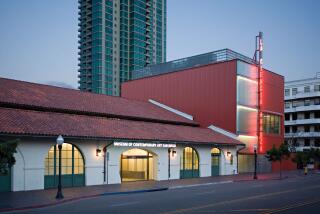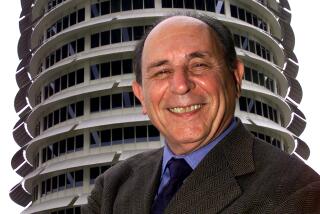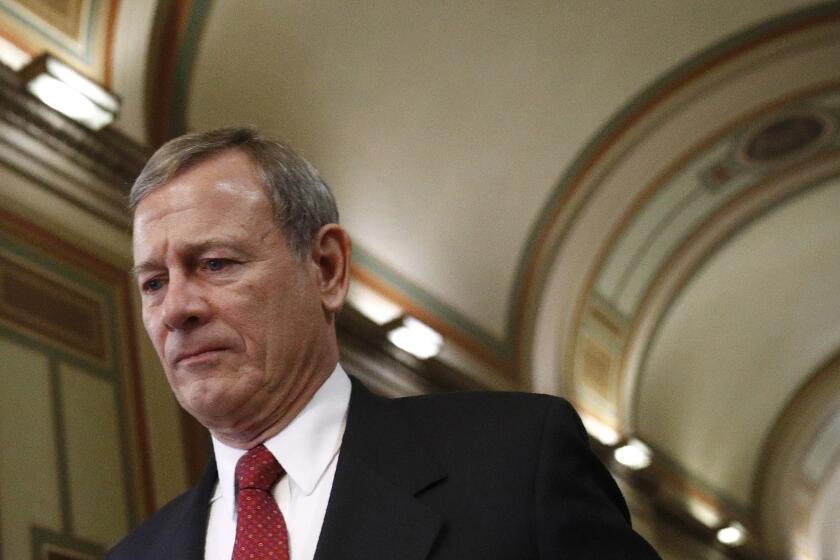Ralph Nader: From consumer advocate to museum impresario
- Share via
WINSTED, Conn. _ This aging but charming town in western Connecticut has had one claim to fame for many years: It’s the hometown of Ralph Nader.tmpplchld And Nader, 81, who left for the Ivy League and gained fame 50 years ago exposing the unsafe practices of the auto industry, is returning the love.tmpplchld The consumer advocate and former presidential candidate has opened a museum in his hometown: the American Museum of Tort Law.tmpplchld Nader has always used the law to extract documents and information to expose defective products or practices.tmpplchld Starting in the 1960s, Nader led crusades against corporations that resulted in auto safety laws and the creation of federal agencies to protect the environment, workers and consumer products. He was also instrumental in enactment of the Freedom of Information Act.tmpplchld He had a knack for capturing the national spotlight and used it to promote consumer advocacy and public interest law.tmpplchld A tort is a wrongful act or an infringement of a right. At a dedication ceremony Sept. 26 held in the church next door to the museum because it could hold more people, Nader joked that people thought he was opening a museum about baking. A torte is a type of cake.tmpplchld But Nader thinks that people not knowing a word is the first step in getting them engaged.tmpplchld But Nader thinks that people not knowing a word is the first step in getting them engaged.tmpplchld “There’s not a single museum devoted to law in the U.S.,” he said in an interview. “This museum relates to everybody’s daily experience: cars, health issues, spills of oil. This is a very unique museum in every way.”tmpplchld Is it a museum to Nader, who is the founder, president and chief fundraiser? Not really. Only one of his cases, the landmark Nader v. General Motors Corp., is on display with several dozen other examples.tmpplchld The museum is in a large, gray stone neoclassical former bank building with Palladian windows that look out onto Main Street.tmpplchld The centerpiece of the exhibits is a shiny red Chevrolet Corvair, the GM product that Nader exposed as dangerous in his 1965 book, “Unsafe at Any Speed.” GM responded with a harassment campaign against him, hiring private detectives to find dirt to discredit him. The company wiretapped him and hired prostitutes to lure him into compromising situations. Nader’s response was the lawsuit, which led to a settlement and an apology from the company’s CEO before a Senate committee.tmpplchld To a surprising degree, the designers rely on cartoon graphic art on large boards to explain the lawsuits.tmpplchld For example, the 1992 case of Stella Liebeck, a 79-year-old woman severely burned by McDonald’s coffee that she spilled in her lap, is shown with a large cup of coffee and the burger empire’s trademark golden arches.tmpplchld tmpplchld Liebeck won the suit with a multimillion-dollar judgment. But it was widely ridiculed at the time by late-night talk show comedians and tort reformers. The exhibit focuses on her lawyer’s findings that McDonald’s kept its coffee unusually hot _ 190 degrees _ and the spill caused third-degree burns.tmpplchld There are also several interactive screens that use photographs and news reports. One is the famous 1972 case, Galella v. Onassis, a suit and countersuit involving former first lady Jacqueline Kennedy Onassis and Ron Galella, known as “king of the paparazzi,” the aggressive photographers who chase after celebrities. He was ordered to stay 50 yards away from her and her children.tmpplchld “This museum is a museum of visual communication,” Nader said. “It has to excite, inform and arouse curiosity.”tmpplchld tmpplchld There aren’t many actual artifacts �� aside from a display of dangerous toys, the Corvair and a few others �� that are usually the mainstay of museums. Nader said it has been hard to acquire them and hopes that more will become available now that the museum is open.tmpplchld Nader got the idea for a museum in 1998, when he was talking to a lawyer who had finished a case and used many elaborate exhibits for trial. Nader wondered what would happen to the exhibits and was told that they would either be saved or, more likely, thrown away. He began thinking about creating a place for tort law.tmpplchld Joseph Page, professor emeritus at Georgetown University Law Center and a law school classmate of Nader’s, picked the cases, starting from the Middle Ages, that are exhibited on a timeline.tmpplchld “No one else did it, so we did it,” Nader said of his 15-year effort to pull together a museum out of what started out as a conversation. The museum so far has cost just under $3 million. Founding donors were asked to give $50,000 each, with Nader contributing $150,000 to pay for the building and exhibits.tmpplchld tmpplchld Founding members are largely trial lawyers, such as the late Dallas attorney Frederick Baron, who represented nuclear plant whistleblower Karen Silkwood; Houston personal injury lawyer Joe Jamail Jr.; and North Carolina attorney Mona Lisa Wallace. Former talk show host Phil Donahue is also a donor.tmpplchld tmpplchld Mark Green, a public interest lawyer who got his start with Nader and went on to become New York City’s first public advocate, said of the museum: “I love it. The piece de resistance is the Corvair and the cartoonization of these serious issues.”tmpplchld The museum’s executive director, Richard Newman, plans traveling exhibits to go to schools and for students to take field trips to the town. Plans are already in the works for an expansion that calls for building a large courtroom so visitors can get a feel for being in court, and which will hold mock trials.tmpplchld tmpplchld Winsted, population 7,700, is quite a bit off the beaten path.tmpplchld “It’s actually easier than you think,” said Richard Blumenthal, D-Conn., a former trial lawyer and the state’s longtime attorney general before being elected to the U.S. Senate in 2010.tmpplchld Winsted is about 45 minutes west of Hartford. “It will be a destination,” he said.tmpplchld Susan Cane, owner of The Creative Stitch, a quilting and sewing shop a few doors down from the museum, said: “I think it’s fantastic. I hope it brings lots of people to Winsted.”tmpplchld ___tmpplchld (c)2015 McClatchy Washington Bureautmpplchld Visit the McClatchy Washington Bureau at www.mcclatchydc.comtmpplchld Distributed by Tribune Content Agency, LLC.tmpplchld
More to Read
Sign up for Essential California
The most important California stories and recommendations in your inbox every morning.
You may occasionally receive promotional content from the Los Angeles Times.










